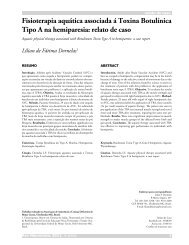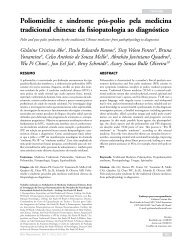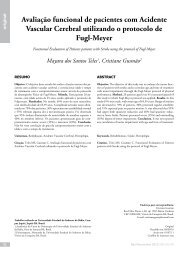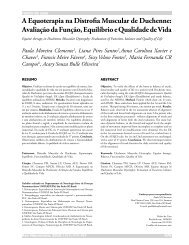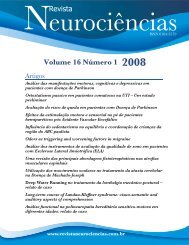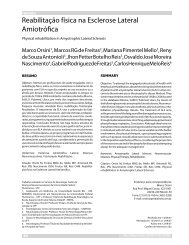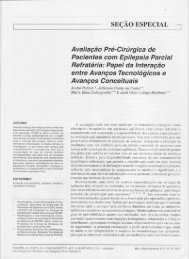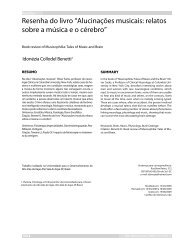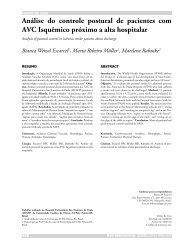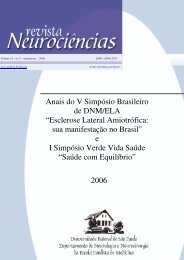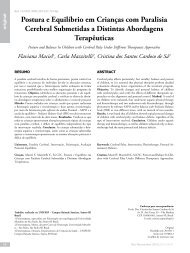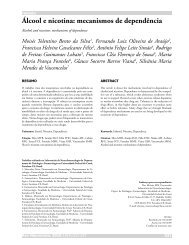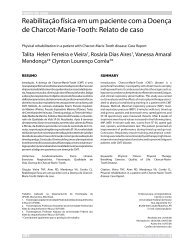Treino Locomotor com Suporte de Peso Corporal na Lesão Medular ...
Treino Locomotor com Suporte de Peso Corporal na Lesão Medular ...
Treino Locomotor com Suporte de Peso Corporal na Lesão Medular ...
You also want an ePaper? Increase the reach of your titles
YUMPU automatically turns print PDFs into web optimized ePapers that Google loves.
motor recovery. Arch Phys Med Rehabil 2002;83:683-91.http://dx.doi.org/10.1053/apmr.2002.3248813.Lindquist ARR, Silva IAB, Barros RML, Mattioli R. A influência da estimulaçãoelétrica funcio<strong>na</strong>l associada ao trei<strong>na</strong>mento em esteira <strong>com</strong> suporteparcial <strong>de</strong> peso <strong>na</strong> marcha <strong>de</strong> hemiparéticos. Rev Bras Fisioter 2005;9:109-12.14.Dobkin BH, Apple D, Barbeau H, Basso M, Behrman A, Deforge D, etal. Methods for a randomized trial of weight-supported treadmill trainingversus conventio<strong>na</strong>l training for Walking during inpatient rehabilitation afterin<strong>com</strong>plete traumatic spi<strong>na</strong>l cord injury. Neurorehabil and Neural Repair2003;17:153-66.http://dx.doi.org/10.1177/088843900325550815.Threlkeld AJ, Cooper LD, Monger BP, Craven AN, Haupt HG. Temporospatialand kinematic gait alterations during treadmill walking with bodyweight suspension. Gait and Posture 2003;17:235-45.http://dx.doi.org/10.1016/S0966-6362(02)00105-416.Duysens J, Crommert H. Van <strong>de</strong> Neural control of lo<strong>com</strong>otion; Part 1: Thecentral pattern generator from cats to humans. Gait and Posture 1998;7:131-41.http://dx.doi.org/10.1016/S0966-6362(97)00042-817.Schindl MR, Kern H, Hesse S. Treadmill training with partial body weightsupport in no<strong>na</strong>mbulatory patients with cerebral palsy. Arch Phys Med Rehabil2000;81:301-6.http://dx.doi.org/10.1016/S0003-9993(00)90075-318.Miyai I, Fujimoto Y, Veda Y, Ueda Y, Yamamoto H, Nozaki S, et al. Treadmilltraining with body weight support: its effect on Parkinson’s disease. ArchPhys Med Rehabil 2000;81:849-52.http://dx.doi.org/10.1053/apmr.2000.443919.Crommert H, Van <strong>de</strong>, Mul<strong>de</strong>r T, Duysens J. Neural control of lo<strong>com</strong>otion:sensory control of the central pattern generator and its relation to treadmilltraining. Gait and Posture 1998;7:251-63.http://dx.doi.org/10.1016/S0966-6362(98)00010-120.Gardner MB, Hol<strong>de</strong>n MK, Keikauskas JM, Ricahrd RL. Partial body weightsupport with treadmill lo<strong>com</strong>otion to improve gait after in<strong>com</strong>plete spi<strong>na</strong>lcord injury: a single-subject experimental <strong>de</strong>sign. Phys Ther 1998;78:361-75.21.Cherniack EP, Caprio D, Fletcher AA, Tuckman J. A novel <strong>de</strong>vice forwalking training in el<strong>de</strong>rly patients. Physiotherapy 1999;85:144-8.http://dx.doi.org/10.1016/S0031-9406(05)65695-722.Field-Fote EC, Tepavac D. Improved intralimb coordi<strong>na</strong>tion in people within<strong>com</strong>plete spi<strong>na</strong>l cord injury following training with body weight support an<strong>de</strong>lectrical stimulation. Phys Ther 2002;82:707-15.23.Visintin M, Barbeau H. The effects of body weight support on the lo<strong>com</strong>otorpattern of spastic paretic patients. Can J Neurol Sci 1989;16:315-25.24.Barbeau H, Visintin M. Optimal out<strong>com</strong>es obtained with body-weightsupport <strong>com</strong>bined with treadmill training in stroke subjects. Arch Phys MedRehabil 2003,84:1458-65.http://dx.doi.org/10.1016/S0003-9993(03)00361-725.Haupenthal A, Schutz GR, Souza PV, Roesler H. Análise do suporte <strong>de</strong> pesocorporal para o treino <strong>de</strong> marcha. Fisioterapia em movimento 2008;21:85-92.26.May<strong>na</strong>rd FM Jr, Bracken MB, Creasey G, Ditunno JF Jr, Donovan WH,Ducker TB, et al. Inter<strong>na</strong>tio<strong>na</strong>l Standards for Neurological and Functio<strong>na</strong>lClassification of Spi<strong>na</strong>l Cord Injury. American Spi<strong>na</strong>l Injury Association. Spi<strong>na</strong>lCord 1997;35:266-74.http://dx.doi.org/10.1038/sj.sc.310043227.Wernig A, Müller S. Laufband lo<strong>com</strong>otion with body weight supportimproved walking in persons with severe spi<strong>na</strong>l cord injuries. Paraplegia1992;30:229-38.http://dx.doi.org/10.1038/sc.1992.6128.Wernig A, Müller S, Na<strong>na</strong>ssy A, Cagol E. Laufband therapy based on ‘rulesof spi<strong>na</strong>l lo<strong>com</strong>otion’ is effective in spi<strong>na</strong>l cord injured persons. Eur J Neurosci1995;7:823-9.http://dx.doi.org/10.1111/j.1460-9568.1995.tb00686.x29.Wernig A, Na<strong>na</strong>ssy A, Müller S. Mainte<strong>na</strong>nce of lo<strong>com</strong>otor abilities followingLaufband (treadmill) therapy in para- and tetraplegic persons: follow-upstudies. Spi<strong>na</strong>l Cord 1998;36:744-9.http://dx.doi.org/10.1038/sj.sc.310067030.Nymark J, DeForge D, Barbeau H, Badour M, Bercovitch S, Tomas J, et al.Body Weight Support Treadmill Gait Training in the Subacute Recovery Phaseof In<strong>com</strong>plete Spi<strong>na</strong>l Cord Injury. Neurorehabil Neural Repair 1998;12:119-36.http://dx.doi.org/10.1177/15459683980120030731.Behrman AL, Harkema SJ. <strong>Lo<strong>com</strong>otor</strong> training after human spi<strong>na</strong>l cordinjury: a series of studies. Phys Ther 2000;80:688-700.32.Protas EJ, Holmes A, Qureshy H, Sherwood AM. Supported treadmill ambulationtraining after spi<strong>na</strong>l cord injury: a pilot study. Arch Phys Med Rehábil2001;82:825-31.http://dx.doi.org/10.1053/apmr.2001.2319833.Field-Fote EC. Combined use of body weight support, functio<strong>na</strong>l electricstimulation, and treadmill training to improve walking ability in individualswith chronic in<strong>com</strong>plete spi<strong>na</strong>l cord injury. Arch Phys Med Rehabil2001;82:818-24.http://dx.doi.org/10.1053/apmr.2001.2375234.Júnior CSA, Abreu CC, Biase ME, Ribeiro LHS. <strong>Treino</strong> lo<strong>com</strong>otor <strong>com</strong>suporte em solo. Revista <strong>de</strong> Medici<strong>na</strong> Física e Reabilitação.(última atualização:07/2003; citado em: 06/2010). Dispónivel em: http://www.spmfr.org.br.35.Postans NJ, Hasler JP, Gra<strong>na</strong>t MH, Maxwell DJ. Functio<strong>na</strong>l electric stimulationto augment partial weight-bearing supported treadmill training forpatients with acute in<strong>com</strong>plete spi<strong>na</strong>l cord injury: a pilot study. Arch Phys MedRehabil 2004;85:604-10.http://dx.doi.org/10.1016/j.apmr.2003.08.08336.Stewart BG, Tarnopolsky MA, Hicks AL, McCartney N, Mahoney DJ,Staron RS, et al. Treadmill training induced adaptations in muscle phenotypein persons with in<strong>com</strong>plete spi<strong>na</strong>l cord injury. Muscle Nerve 2004;30:61-8.http://dx.doi.org/10.1002/mus.2004837.Phillips SM, Stewart BG, Mahoney DJ, Hicks AL, McCartney N, Tang JE,et al. Body-weight-support treadmill training improves blood glucose regulationin persons with in<strong>com</strong>plete spi<strong>na</strong>l cord injury. J Appl Physiol 2004;97:716-24.http://dx.doi.org/10.1152/japplphysiol.00167.200438.Behrman AL, Lawless-Dixon AR, Daviis SB, Bowdwn MG, Nair CP, HannoldEM, et al. <strong>Lo<strong>com</strong>otor</strong> Training Progression and out<strong>com</strong>es after in<strong>com</strong>pletespi<strong>na</strong>l cord injury. Phys Ther 2005;85:1356-71.39.Field-Fote EC, Lindley SD, Sherman AL. <strong>Lo<strong>com</strong>otor</strong> training approachesfor individuals with spi<strong>na</strong>l cord injury: A prelimi<strong>na</strong>ry report of walking-relatedout<strong>com</strong>es. J Neurol Phys Ther 2005;29:127-38.40.Effing TW, van Meeteren NL, van Asbeck FW, Prevo AJ. Body weightsupportedtreadmill training in chronic in<strong>com</strong>plete spi<strong>na</strong>l cord injury: a pilotstudy evaluating functio<strong>na</strong>l health status and quality of life. Spi<strong>na</strong>l Cord.2006;44:287-96.http://dx.doi.org/10.1038/sj.sc.310184141.Lucareli PR, Silva MM, Ber<strong>na</strong>rddi AA, Greeve JMA. Esteira <strong>com</strong> suporte<strong>de</strong> peso corpóreo em pacientes <strong>com</strong> lesão medular. In: XII Congresso Brasileiro<strong>de</strong> Biomecânica, São Pedro. A<strong>na</strong>is do XII Congresso Brasileiro <strong>de</strong> Biomecânica,2007, v.1. p. xx-xx.42.Lucareli PR, Lima MO, Lima FP, Garbelotti SA Jr, Gimenes RO, AlmeidaJG, et al. Gait a<strong>na</strong>lysis and quality of life evaluation after gait training in patientswith spi<strong>na</strong>l cord injury. Rev Neurol 2008;46:406-10.43.Behrman AL, Nair PM, Bow<strong>de</strong>n MG, Dauser RC, Herget BR, MartinrevisãoRev Neurocienc 2011;19(4):702-710709



